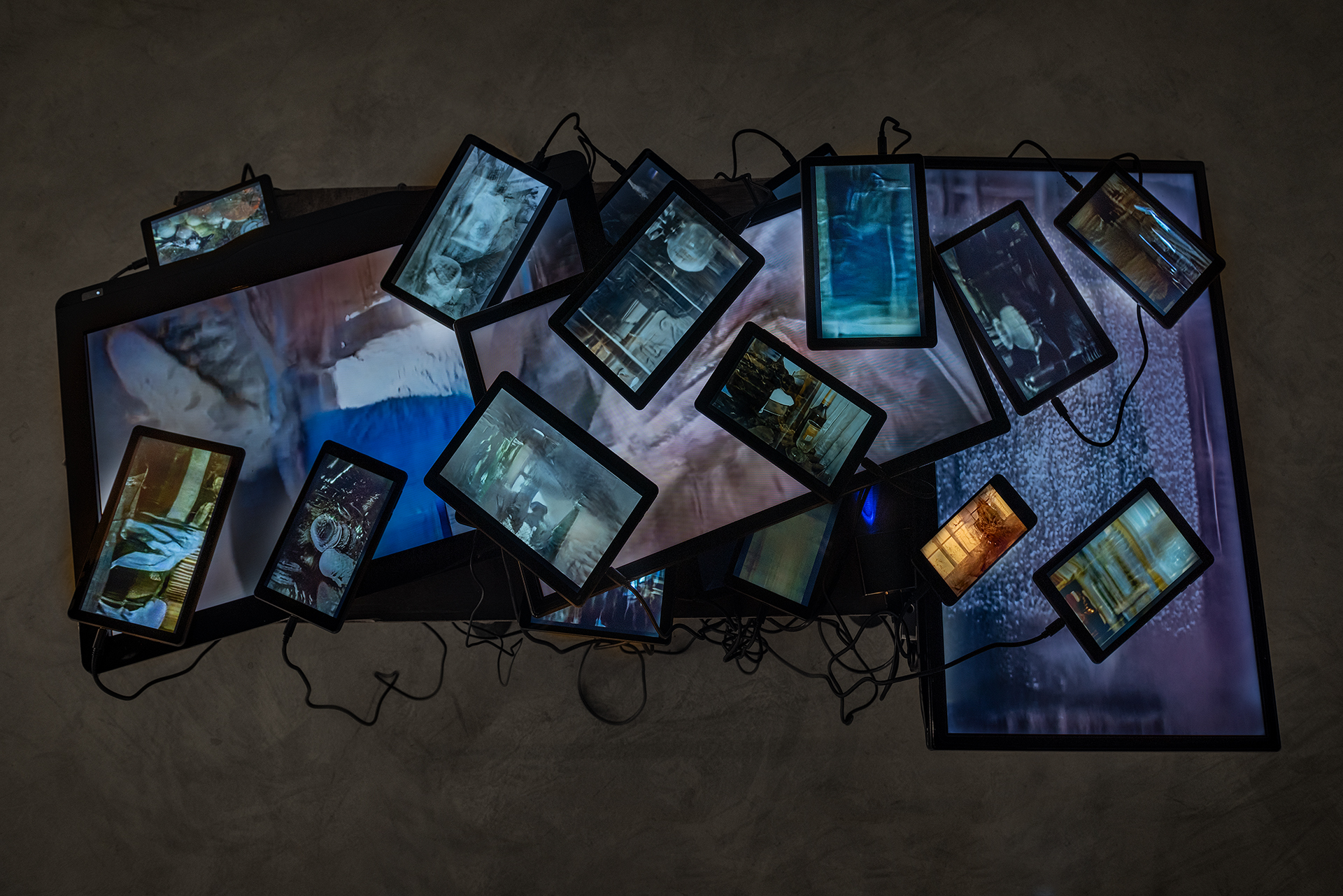Upcoming
June 13 - July 20, 2024
a movement of darkness on darkness
Sasha Opeiko
 Sasha Opeiko, veils into dark places (detail), 2023, found objects, photo prints, digital video, digital sound. Photo credit: Frank Piccolo
Sasha Opeiko, veils into dark places (detail), 2023, found objects, photo prints, digital video, digital sound. Photo credit: Frank Piccolo
“And what is this death that always rises from within, but that must arrive from without—and that, in the case of capitalism, rises with all the more power as one still fails to see exactly what this outside is that will cause it to arrive?”¹
Melancholy is a depressive movement inward, a withdrawal from relations that dissolves the subject into the doom of dreaded mortality through temporal distortions and the paralyzing horrors of existence. Melancholy simultaneously recoils from mortality and finds solace in the prospect of finitude. In antiquity black bile was the culprit of melancholy; in psychoanalysis the cause is an obsessive fixation on a lost, often unidentifiable object; in psychiatry causes can vary from trauma and stress to chemical imbalances that echo the archaic disequilibrium of black bile. Historically, melancholy has been at times affiliated with darkness and the putrefaction of matter, acting as precedent to the question of whether it is possible to consider the concept of melancholy in nonhuman terms.
This exhibition explores and manipulates the melancholic attributes of objects—processes of fragmented disintegration, symbolic incoherence, and temporal displacement. Here melancholy is dispersed and diffracted through fragmentation rather than experienced as subjective reflective introspection, proliferating through constellations of objects and sets of relations.
Decomposition, putrefaction, desiccation, disintegration, rot, black bile—these viscous movements cultivate darkness in the real, folding emptiness and antiproduction into objects of withdrawal and hesitation. Decay is not only a state of putrefaction succeeding a life, but a perpetual state of being, a movement of darkening into cosmic extinction. This living putrefaction is the animated torpor of the death drive, inherent to both organic and inorganic entities.
Fragmented traces of collected melancholic visual content are translated through machine learning, video editing, and glitch to assemble media installations that collectively unsettle symbolic codes in the appropriated content while generating new sets of melancholic operations. Visually, the works in this exhibition focus on the cultural dissemination of motifs as leftover traces of established conceptions of melancholy.
Distorted images of ghostly ruination are positioned alongside found objects—the waste and debris of capitalist production. The work is thus both about the decay of materiality and the disintegrative processes of late capitalism, which is itself an immense nonhuman entity fixated on consumption and exhaustive self-destruction.
The use of found objects combines mediation and assemblage to produce diffractions of memento mori still life tropes. Memento mori is the name for an overcoded motif but also for the disintegrative effects of the death drive that produce melancholic effects in materiality. The work follows not so much a reiteration of traditional memento mori still life tropes but a mediated dispersal of decaying objects and images-as-objects.
There is a play of tension between the objects and their visual, digital reproductions. Appropriated fragments of video, 3D scans, and 3D prints are mediated through channels of data flows and digital translations. The darkness of the black box—the invisible operations in digital transcoding—is utilized to achieve unpredictable results, allowing the nonhuman algorithmic life form to operate on its own terms.
In mediating found materials, there are residues of qualities that become temporally misplaced remnants, or ghosts, traversing flows of fragmentation and decay. The exhibition aims to present aggregates of nonhuman melancholic traits, uncovering surface qualities that appear as traces of absence, or darkness, while forging constellations of dispersed fragments.
About the artist
Based in London, ON, Sasha Opeiko’s artistic research explores redefinitions of melancholy in relation to the nonhuman to investigate decay and the dark reality of objects in the context of late capitalism. She has exhibited widely at galleries such as Art Windsor-Essex, Thames Art Gallery, and Art Gallery of Peterborough. She has received several grants and awards, including the Canada Council for the Arts Project Grant to Visual Artists, Ontario Arts Council’s Visual Artists Creation Projects Grant, and the SSHRC Doctoral Award.
Related Programming
Opening Reception
Thursday, June 13 from 5:00 to 7:00p.m.
Free | Open to the public


